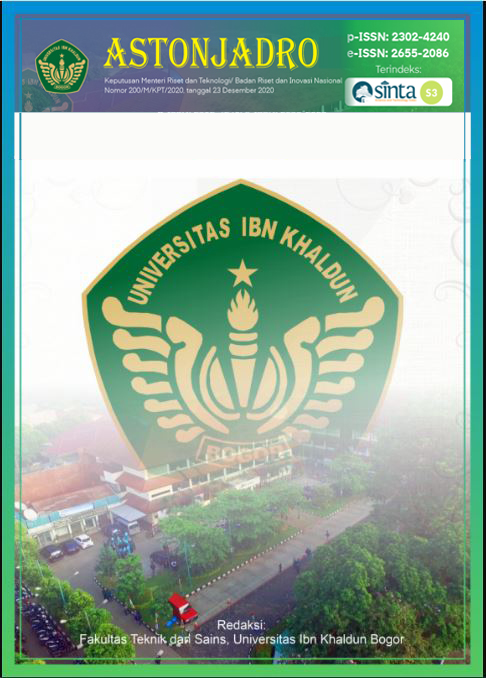Characteristics of Slum Housing at TPA Suwung
DOI:
https://doi.org/10.32832/astonjadro.v11i3.7175Keywords:
characteristics, visual, road corridor, commercial, corridor.Abstract
Economic development in urban areas indirectly changes the function of residential areas into commercial areas. Along with the development of the function of the Gajah Mada area, the threat of decreasing the visual quality of Jalan Gajah Mada as an artifact of the corridors of the Denpasar Old Town area naturally cannot be avoided. The need for increased trading space, high building density, development of economic functions that are more commercial in nature due to the demands of profit and modernization as well as a slum environment can also eliminate the visual character of the physical corridor of Jalan Gajah Mada which still retains the characteristics of Balinese architecture and the image of Kota Tua because Therefore, it is necessary to study the visual characteristics of the physical corridors of Jalan Gajah Mada so that directions regarding the arrangement should be considered in accommodating changes in the physical corridors so that they remain visually aligned. This research method is a type of descriptive research using qualitative methods. Descriptive research is a research that aims to provide a systematic, factual, accurate description of the facts and characteristics of the population so that it can produce the physical characteristics of the Jalan Gajah Mada corridor as seen from the path elements, architectural patterns and street trees that surround the corridor.
References
Alit, I. K. (2005). Pemberdayaan Masyarakat dalam Peningkatan Kualitas Lingkungan Permukiman Kumuh di Propinsi Bali. Jurnal Permukiman Natah, 3(1), 34–43.
Aliyati, R. (2011). Permukiman Kumuh di Bantaran Ci- Liwung (Studi Kasus Kel Manggarai-Srengseng Sawah dan Kel Kampung Melayu-Kalisari). Universitas Indonesia.
Bani Perdanawati Hasanuddin. (2014). Implementasi Revitalisasi Permukiman Kumuh di Kota Makassar (Neighborhood Upgrading and Shelter Sector Project).
C.Chandramouli, I. A. S. (2003). Slums In Chennai: A Profile. Paper Presented at the Third International Conference on Environment and Health, 82–88.
Denpasar, D. P. K. (2018). Dokumen Teknis Penataan Lingkungan Permukiman Berbasis Komunitas (PLPBK).
Denpasar, W. (2016). SK Walikota Denpasar.
Djaali. (2008). Skala Likert.
Doxiadis, C. A. (1976). Ekistics, the Science of Human Settlements. International Journal of Environmental Studies, 9(1), 11–19.
Field, A. (2009). Discovering Statistics Using SPSS.
Firdaus, F. M., & Nurini. (2015). Arahan Penataan Kampung Nelayan Kejawan Lor Dengan Konsep Livable Settlement Pantai Kenjeran, Surabaya. Ruang, 1(4), 201–210. https://doi.org/HTTP://DX.DOI.ORG/10.14710/RUANG.1.4.201-210
Fitria, N., & Setiawan, R. P. (2014). Identifikasi Karakteristik Lingkungan Permukiman Kumuh di Kelurahan Kapuk, Jakarta Barat. JURNAL TEKNIK POMITS, 3(2), C240–C244.
Gultom, L. H., & Sunarti. (2017). Pengaruh Penataan Permukiman Kumuh Untuk Mencapai Livable Settlement di Kelurahan Tambakrejo Kota Semarang. Jurnal Pengembangan Kota, 5(1), 140–148. https://doi.org/10.14710/jpk.5.2.140-148
Habitat, U. (2003). Slums of the World: the Face of Urban Poverty in the New Millennium.
Hariyanto, A. (2010). Strategi Penanganan Kawasan Kumuh Sebagai Upaya Menciptakan Lingkungan Perumahan dan Permukiman yang Sehat (Contoh Kasus : Kota Pangkalpinang). Perencanaan Wilayah Dan Kota UNISBA, 7(2), 11–37.
Imam Ghozali. (2011). Aplikasi Analisis Multivariate Dengan Program SPSS.
Krisandriyana, M., Astuti, W., & Fitriarini, E. (2019). Faktor yang Mempengaruhi Keberadaan Kawasan Permukiman Kumuh di Surakarta. Desa-Kota, 1(1), 24–33.
Kurniasih, S. (2007). Usaha Perbaikan Permukian Kumuh Di Petukangan Utara Jakarta Selatan. Universitas Budi Luhur.
Nursyahbani, R., & Pigawati, B. (2015). Kajian Karakteristik Kawasan Pemukiman Kumuh di Kampung Kota (Studi Kasus: Kampung Gandekan Semarang). Jurnal Teknik PWK, 4(2), 267–281.
Rizka, H., Purwoko, A., & Rujiman. (2018). Perencanaan Penanganan Kawasan Pemukiman Kumuh Di Kelurahan Tanjung Tiram Kabupaten Batubara. Jurnal Serambi Energi, III, 321–329.
Sugiyono. (2007). Metode Penelitian Pendidikan, Pendekatan Kuantitatif, Kualitatif dan R&D.
Usman, H., & Akbar, P. S. (2006). Pengantar Statika Edisi Kedua.
Zaini Musthofa. (2011). Evaluasi Pelaksanaan Program Relokasi Permukiman Kumuh (Studi Kaus: Program Relokasi Permukiman di Kelurahan Pucangsawit Kecamatan Jebres Kota Surakarta).
Downloads
Published
How to Cite
Issue
Section
License
Copyright (c) 2022 ASTONJADRO: CEAESJ

This work is licensed under a Creative Commons Attribution-ShareAlike 4.0 International License.
Paper submitted to ASTONJADRO is the sole property of the Astonjadro Journal. Unless the author withdraws the paper because he does not want to be published in this journal. The publication rights are in the journal Astonjadro.ASTONJADRO
LICENSE
This work is licensed under a Creative Commons Attribution-ShareAlike 4.0 International License.
Based on a work at http://ejournal.uika-bogor.ac.id/index.php/ASTONJADRO













